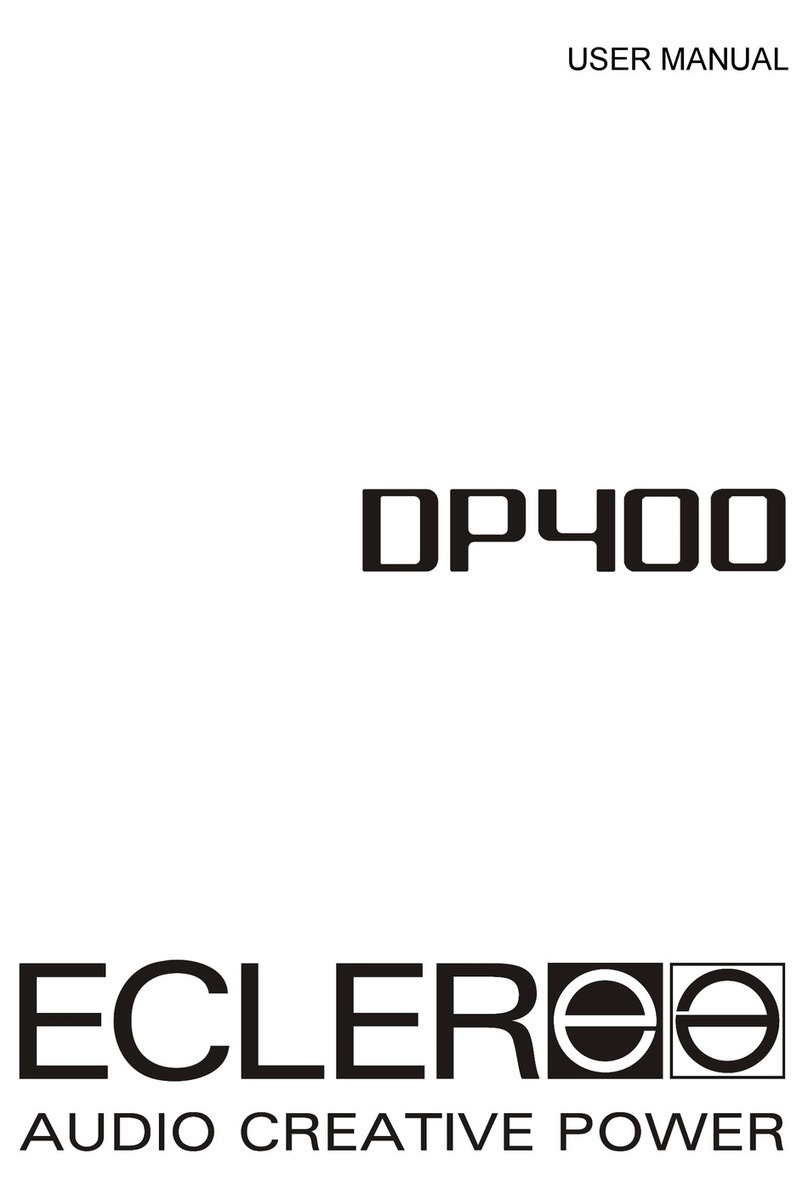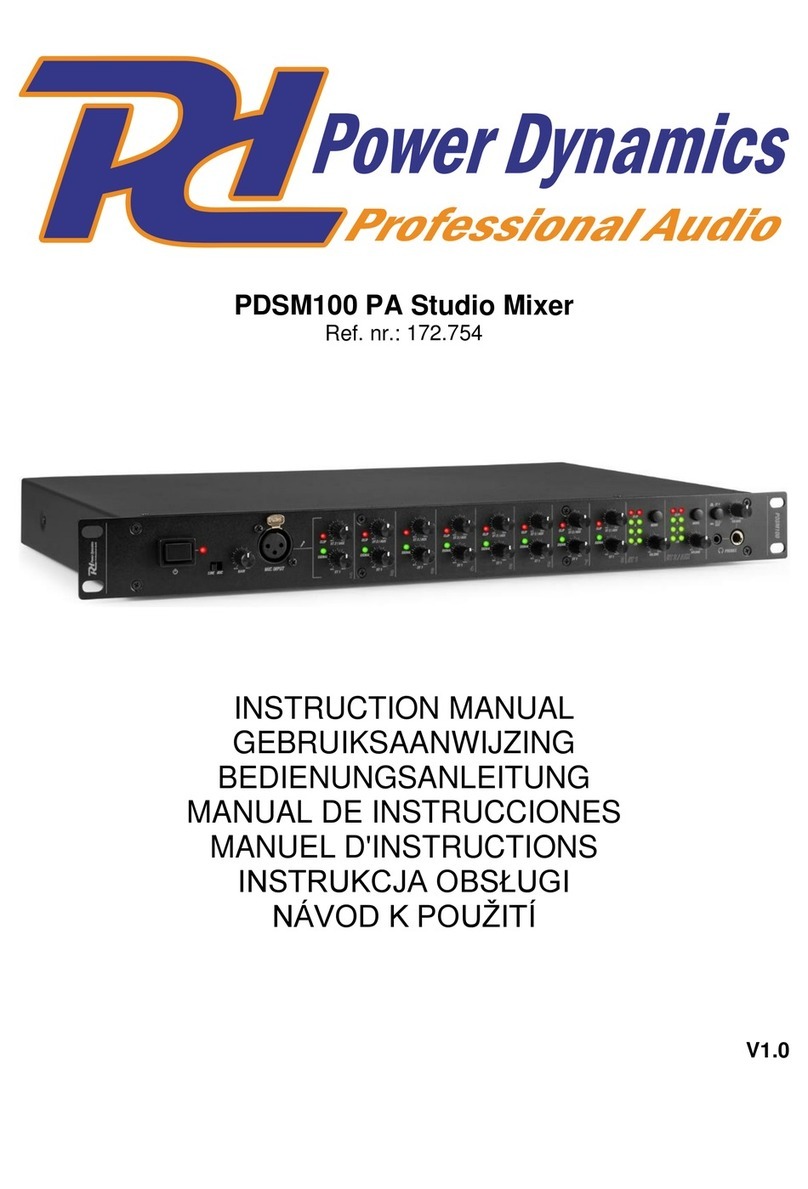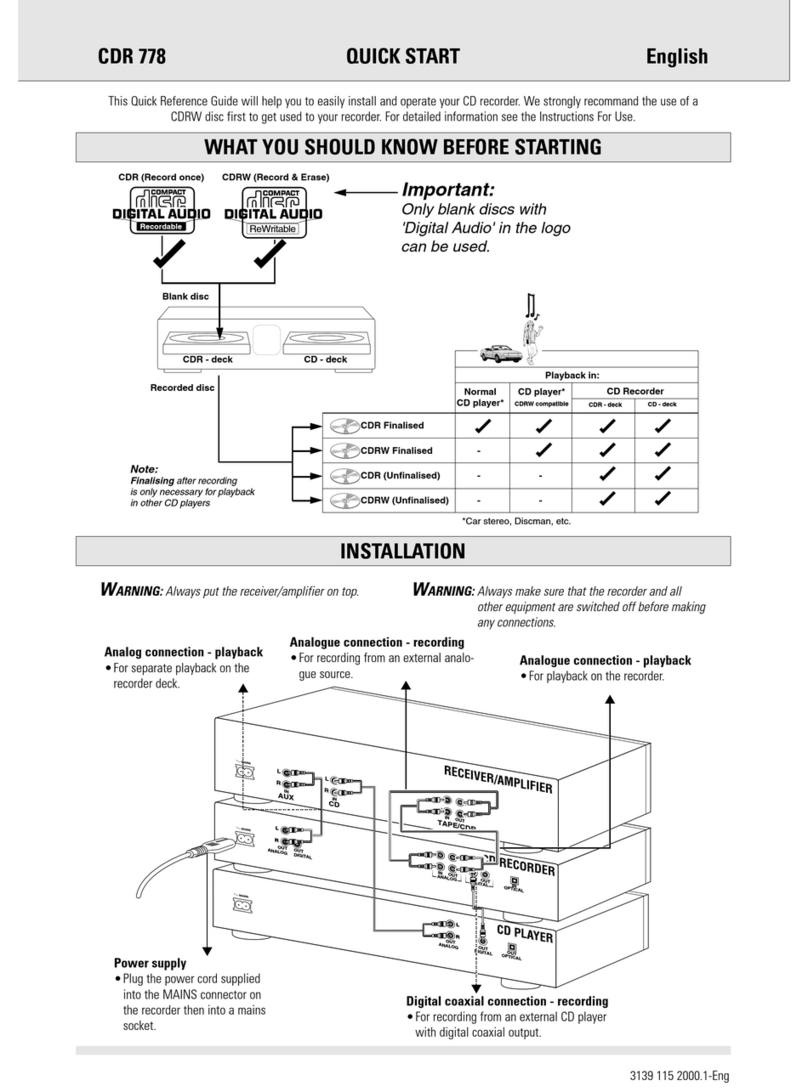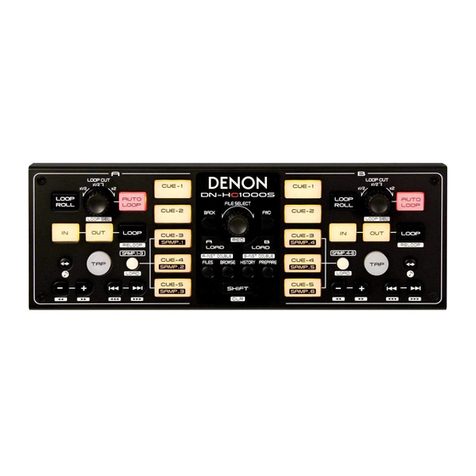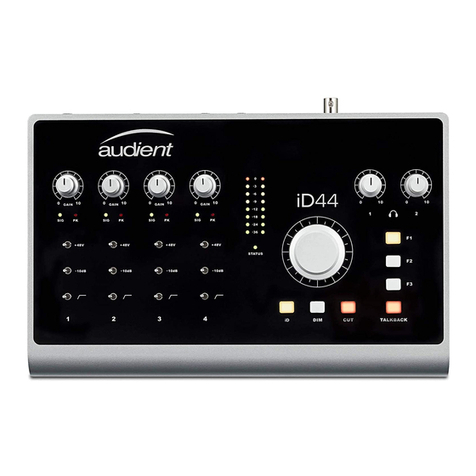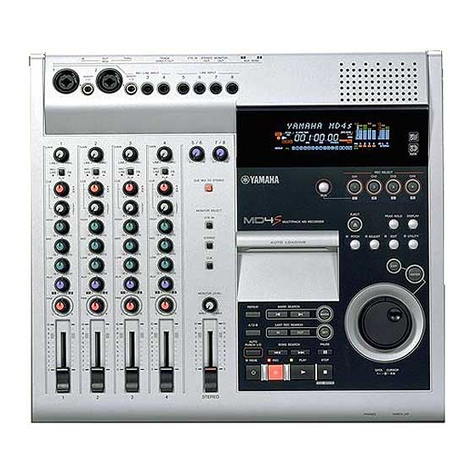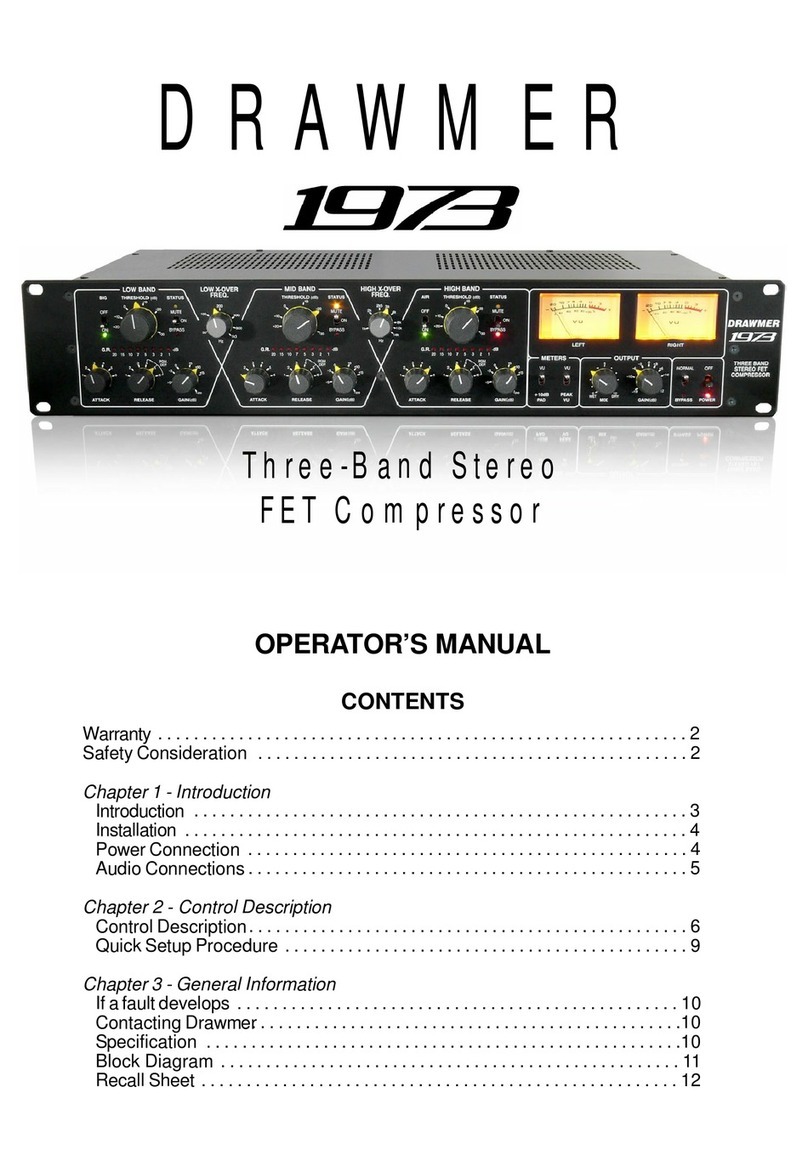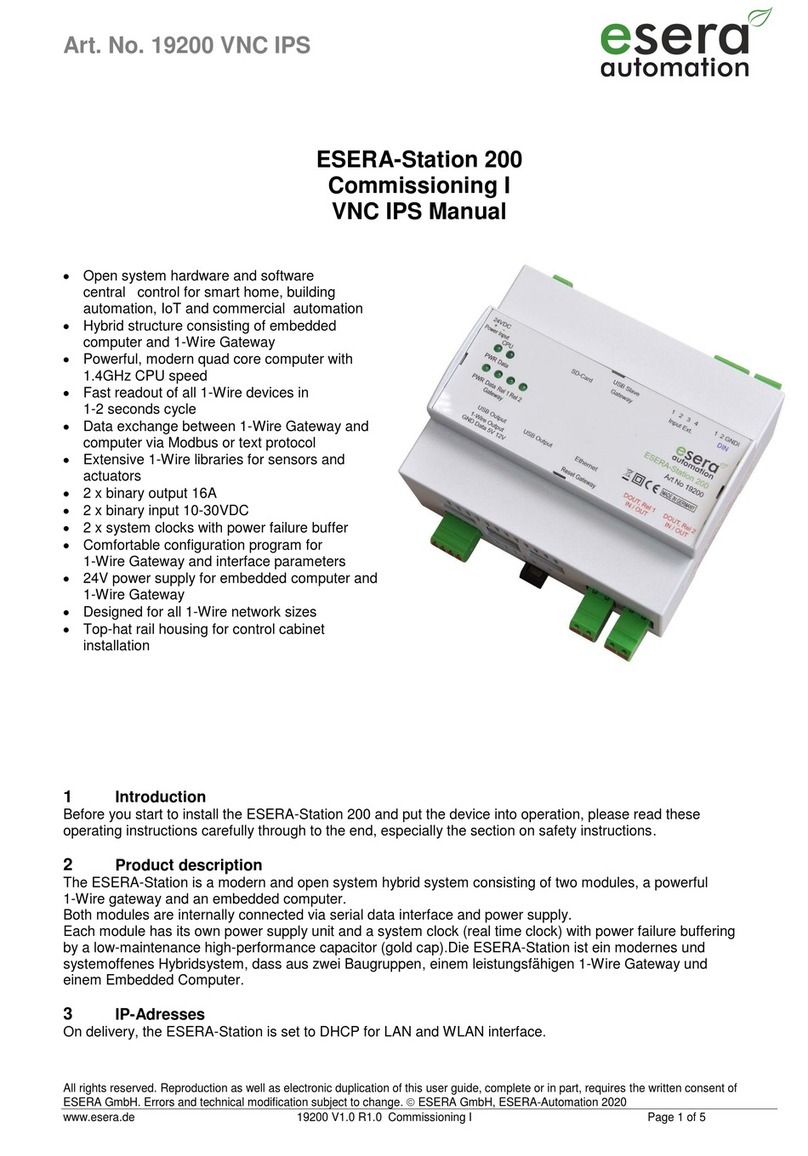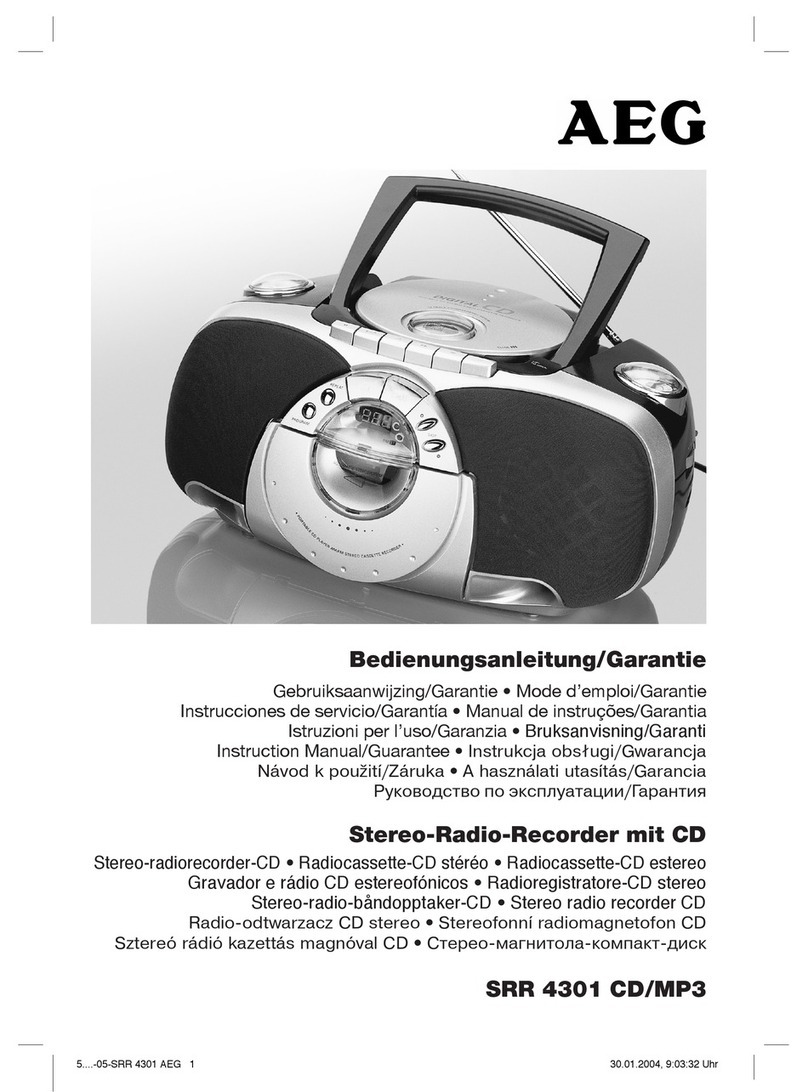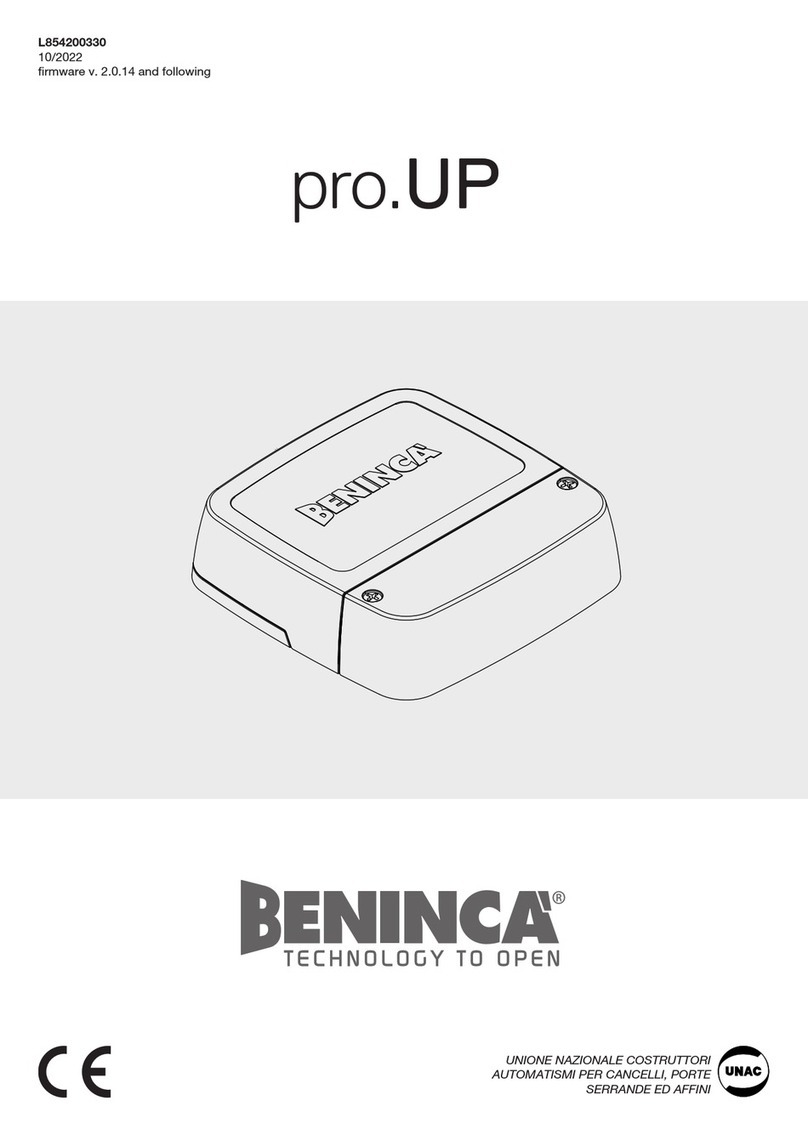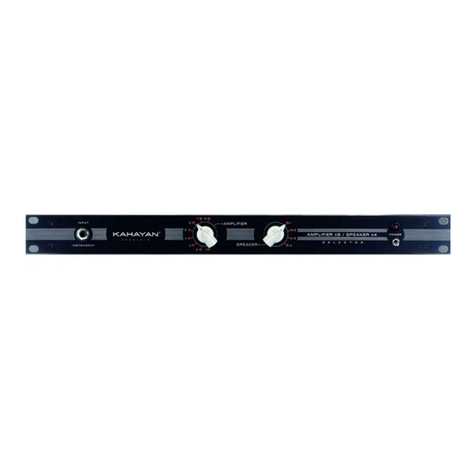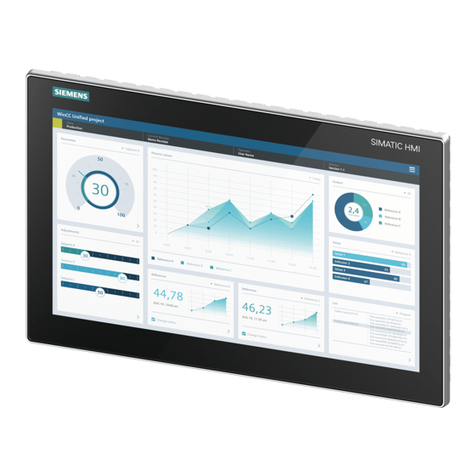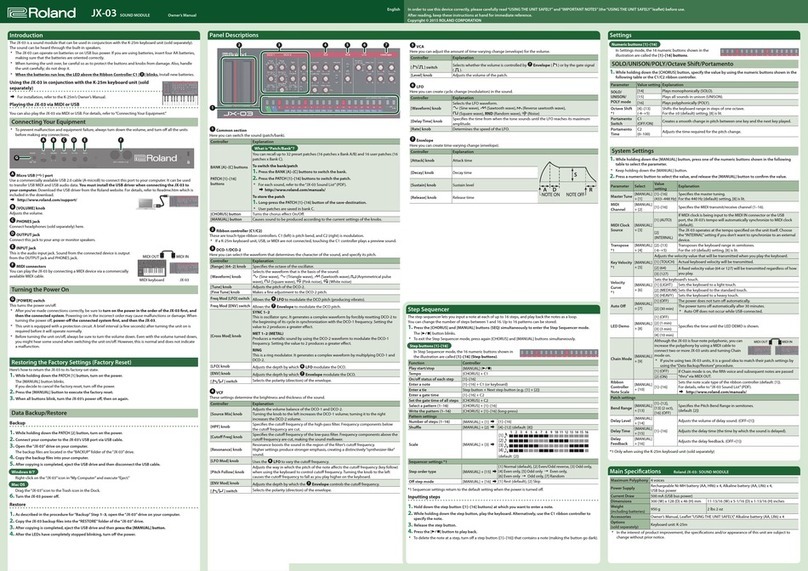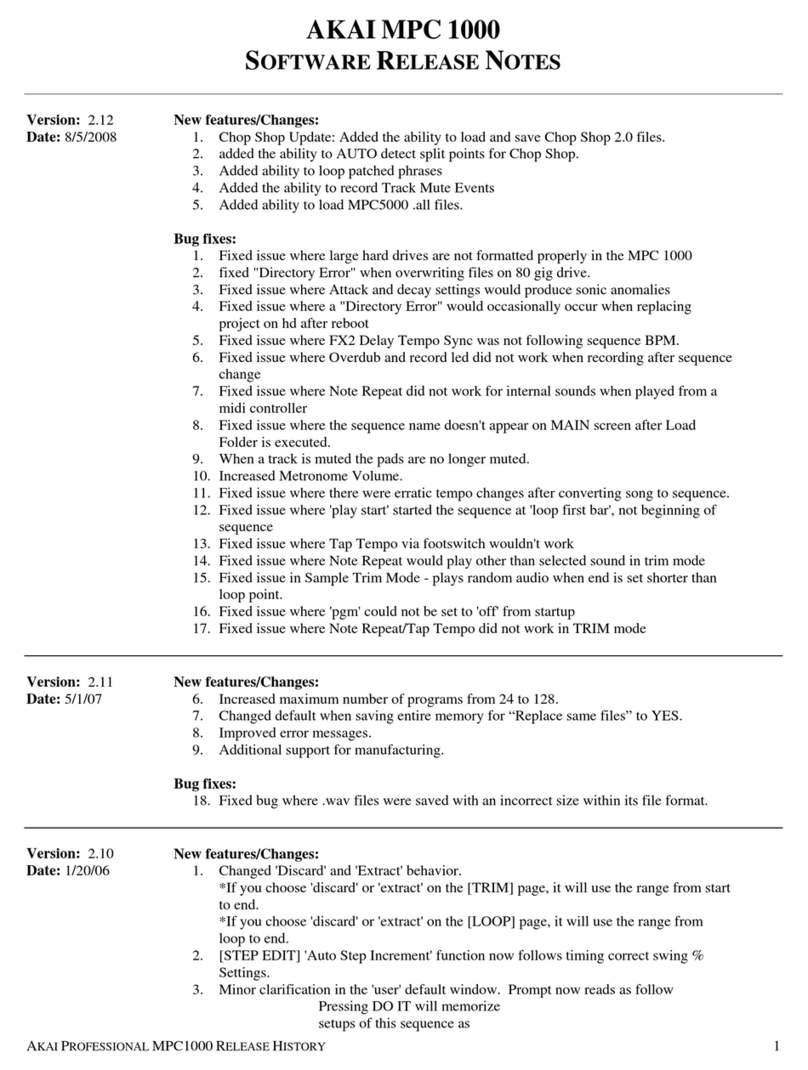Aurora DTX Series User manual

USERS GUIDE
Manual Number: 220105 | Dash Rev: 3.04 or Higher
www.auroramm.com
DTX Series
DTX-44D ● DTX-88D ● DTX-1616D ● DTX-3232D ● DTX-6464D
Dante Based Audio DSP with Analog I/O

www.auroramm.com
ii

www.auroramm.com
ii
TABLE OF CONTENTS
Technology Overview...........................................................................................................................................................5
Introduction to Dash............................................................................................................................................................5
Quick Start.............................................................................................................................................................................5
Hardware................................................................................................................................................................................6
Safety Instructions...............................................................................................................................................................6
Front Panel Features ..........................................................................................................................................................7
Rear Panel Features...........................................................................................................................................................7
Audio Signal Flow Diagram...............................................................................................................................................10
Software...............................................................................................................................................................................11
Software Installation..........................................................................................................................................................11
Software Operation...........................................................................................................................................................12
File Menu...........................................................................................................................................................................12
Settings Menus..................................................................................................................................................................13
Device Setting...............................................................................................................................................................13
GPIO Setting.................................................................................................................................................................14
Group Setting................................................................................................................................................................17
Preset Name .................................................................................................................................................................17
Panel Setting.................................................................................................................................................................17
User Interface................................................................................................................................................................18
Help...................................................................................................................................................................................18
About.............................................................................................................................................................................18
Document......................................................................................................................................................................18
Command Capture........................................................................................................................................................18
Device Tabs ......................................................................................................................................................................18
Device List.........................................................................................................................................................................18
Edit Module .......................................................................................................................................................................19
Upload Parameters to Device...........................................................................................................................................19
Master Slave Indicator ......................................................................................................................................................19
Navigating the Home Tab .................................................................................................................................................20
Channel Layout.............................................................................................................................................................20
Selecting Channels.......................................................................................................................................................20
Changing the Channel Name........................................................................................................................................20
Setting Channel Gain....................................................................................................................................................20
Linking Channels...........................................................................................................................................................20

www.auroramm.com
iii
Channel Pages..............................................................................................................................................................20
Setting Minimum and Maximum Gain...........................................................................................................................20
Accessing Parameters..................................................................................................................................................21
Module Tabs......................................................................................................................................................................22
Inputs.............................................................................................................................................................................22
AutoMixer......................................................................................................................................................................22
AEC...............................................................................................................................................................................22
ANS...............................................................................................................................................................................23
Matrix.............................................................................................................................................................................23
Outputs..........................................................................................................................................................................23
Meters ...........................................................................................................................................................................24
Camera..........................................................................................................................................................................24
System Mute .....................................................................................................................................................................24
Presets..............................................................................................................................................................................24
DSP Channel Modules......................................................................................................................................................25
Adding and Removing DSP Modules............................................................................................................................25
Input Source..................................................................................................................................................................26
Expander.......................................................................................................................................................................27
Compressor...................................................................................................................................................................27
Automatic Gain Control (AGC)......................................................................................................................................28
Parametric EQ...............................................................................................................................................................29
Graphic EQ....................................................................................................................................................................30
Adaptive Feedback Control (AFC)................................................................................................................................31
Gate...............................................................................................................................................................................33
Ducker...........................................................................................................................................................................34
Ambient Noise Compensation (ANC) ...........................................................................................................................34
High and Low Pass Filter..............................................................................................................................................35
Delay .............................................................................................................................................................................36
Output Setting ...............................................................................................................................................................37
DSP System Modules.......................................................................................................................................................38
Gain Sharing Auto Mixer...............................................................................................................................................38
Gating AutoMixer ..........................................................................................................................................................39
Acoustic Echo Cancellation (AEC)................................................................................................................................41
Automatic Noise Suppression (ANS)............................................................................................................................42
Matrix.............................................................................................................................................................................42

www.auroramm.com
iv
Camera Tracking...........................................................................................................................................................43
USB Soundcard.............................................................................................................................................................45
Appendix A: Device Mirroring............................................................................................................................................46
Appendix B: Control Protocol............................................................................................................................................46
External Control.................................................................................................................................................................46
Control Protocol.................................................................................................................................................................46
Protocol Header ............................................................................................................................................................46
Message Type = Parameter SET (0x21)......................................................................................................................47
Message Type = Parameter GET(0x22).......................................................................................................................47
Message Type = Preset SET(0x13)..............................................................................................................................47
Message Type = Other Controls(0x74).........................................................................................................................47
Serial Port to UDP Conversion..........................................................................................................................................48
Appendix C: Module Parameter Types.............................................................................................................................50

www.auroramm.com
5
Technology Overview
Introduction to Dash
The Dash DSP Controller is a Windows-based, full-featured application that configures and controls the DSP hardware.
Systems can be designed to perfectly match specifications and conform as requirements change or evolve. All classes of
audio processing modules for signal routing and shaping are provided.
Dash provides a revolutionary way of thinking about DSP software. This is a software designed by audio professionals for
audio professionals. It uses an interface layout that will be very intuitive to even the most novice integrator yet
extremely powerful in its capabilities.
Quick Start
1. Install Dash software.
2. Connect DTX DSP to the same network as the computer running Dash.
3. Use the PoE connection on a DTX-44D, use the LAN connection on all other DTX devices.
4. Open Dash.
5. Click the plus (+) sign in the Device tab row.
6. Select a template that matches the device you are connecting.
7. Click the ‘Device List’ in the top right corner of Dash.
8. Select the desired device from the list of discovered devices and click ‘Set IP’.
9. Change the IP from the default 169.254.10.227 to a valid, unused static address on the active subnet.
10. Click ‘Connect’.
11. The green ‘LED’ next to the device name on the Device tab should now be green.
12. You are all set!

www.auroramm.com
6
Hardware
Safety Instructions
Please review the following safety precautions. Ifthis is the first time using this model, then read this manual before installing
or using the product. If the product is not functioning properly, please contact your local dealer or Aurora for further
instructions.
The lightning symbol in the triangle is used to alert you to the presence of dangerous voltage inside the product
that may be sufficient to constitute a risk of electric shock to anyone opening the case. It is also used to indicate
improper installation or handling of the product that could damage the electrical system in the product or in other
equipment attached to the product.
The exclamation point in the triangle is used to alert you to important operating and maintenance instructions.
Failure to follow these instructions could result in injury to you or damage to the product.
Be careful with electricity:
Power Outlet: To prevent electric shock, be sure the electrical plug used on the product power cord matches
the electrical outlet used to supply power to the Aurora product. Use the power adapter and power connection
cables designed for this unit.
Power Cord: Be sure the power cord is routed so that it will not be stepped on or pinched by heavy items.
Lightning: For protection from lightning or when the product is left unattended for a long period, disconnect
it from the power source.
Also follow these precautions:
Ventilation: Do not block ventilation slots, if applicable, on the product, or place any heavy object on top of
it. Blocking airflow could cause damage. Arrange components so that air can flow freely. Ensure that there
is adequate ventilation if the product is placed in a stand or cabinet. Put the product in a properly ventilated
area, away from direct sunlight or any source of heat.
Overheating: Avoid stacking the Aurora product on top of a hot component, such as a power amplifier.
Risk of Fire: Do not place unit on top of any easily combustible material, such as carpet or fabric.
Proper Connections: Be sure all cables and equipment are connected to the unit as described in this manual.
Object Entry: To avoid electric shock, never stick anything in the slots on the case, or remove the cover.
Water Exposure: To reduce the risk of fire or electric shock, do not expose to rain or moisture.
Cleaning: Do not use liquid or aerosol cleaners to clean this unit. Always unplug the power to the device
before cleaning.
ESD: Handle this unit with proper ESC care. Failure to do so can result in failure.
FCC
This device complies with Part 15 of the FCC Rules. Operation is subject to the following two (2) conditions:
1. This device may not cause harmful interference.
2. This device must accept any interference received, including interference that may cause undesired operation.
Trademarks
All trademarks in this document are the properties of their respective owners.

www.auroramm.com
7
Front Panel Features
USB (Audio) – USB 2.0 Type A connector. Used in conjunction with the USB Sound card feature. Requires a USB
Type-A to USB Type-A cable, included in box. The USB connection can also be used as a sound card with a PC or
Mac using a generic HID audio. The driver will appear as a “Crestone USB Soundcard” in your computers sound
settings.
Status LED – A green LED indicates network connectivity on the LAN connection.
Power LED – A green LED indicates power to the unit is good.
I/O LEDs – A green LED indicates analog connectivity.
Rear Panel Features
Dante Ethernet – Primary and secondary Ethernet connections for Dante audio. Secondary connection can be used
for to provide redundancy for the Dante audio network or can be used to daisy chain additional devices. PoE is
not passed on.
DTX-44D – 10/100Mbps, PoE PD (15W) on top connector
All Others – 10/100/1000Mbps, no PoE
NOTE: This port has different MAC and IP addresses than the LAN Control Interface (not applicable on DTX-44D).

www.auroramm.com
8
Analog Inputs – Balanced or unbalanced high impedance inputs support Line or Mic level with +48VDC phantom
power. Channel count varies per Model. Mating connectors provided in box.
Signal Label
XLR
TRS
+
Pin 2
Tip
-*
Pin 3
Ring
Pin 1
Sleeve
*do not use (-) for unbalanced
Analog Outputs – Balanced or unbalanced 600Ω outputs. Channel count varies per Model. Mating connectors
provided in box.
Signal Label
XLR
TRS
+
Pin 2
Tip
-
*
Pin 3
Ring
Pin 1
Sleeve
*do not use (-) for unbalanced
Serial Communication – RS-232 and RS-485 connections. A +12VDC connection can be used with along with the
serial connections to power a remote serial device such as a RS-485 control panel. The Ground connection is
shared between the RS-232 and RS-485. Mating connectors provided in box.
Signal Label
Signal
+12V
Aux Power
A
RS-485 A(-)
B
RS-485 B(+)
GND
RX
RS-232 Receive
TX
RS-232 Transmit
DC Power Input – 12VDC, 10W, center positive power Input. Provides alternate power source to PoE. Can be used
simultaneously with PoE for redundant power.
GPIO – General Purpose I/O. The function of the GPIO pins can be configured in the GPIO Settings section of the
Dash Software. Mating connectors provided in box.
Signal Label
Signal
V
+3.3VDC @ 500mA MAX
D
GPIO Common
GND
Below are general definitions of the GPIO depending on how they are defined in Dash:
GPIO Input: The port value is considered ‘High’ if the voltage applied to the ‘D’ pin is greater than 2VDC. The port
value is considered ‘Low’ if the voltage applied to the pin is less than 0.3VDC. Input pins can support up to 12VDC.
GPIO Output: When the port is triggered ‘High’, the ‘D’ pin will output 5VDC with a drive current of 100mA; when
triggered ‘Low’ the pin will equal ground. The maximum total current if all 8 pins are configured as outputs is
500mA.
GPIO ADC Input: When the port is configured as an ADC input, an external potentiometer can be connected as a
volume control.

www.auroramm.com
9
LAN Control Interface – 10/100/1000Mbps Ethernet control interface. Use this interface to connect to Dash control
software or to use UDP commands from a third-party source.
NOTE: This port has different MAC and IP addresses than the Dante Audio ports.
AC Power Input/Switch – 110-240VAC 50/60Hz, 40W Max power inlet via IEC 320 C14 socket. Main power switch
for unit must be in the ON (I) position for normal operation.
Ground Lug – Ground lug to provide chassis ground. Secure to earth ground according to code.

www.auroramm.com
10
+
-
G
+
-
G
+
-
G
+
-
G
+
-
G
+
-
G
Gain
Gain
Signal
Generator
Signal
Generator
Signal
Generator
Signal
Generator
Meters
Meters
Meters
Meters
Meters
Meters
Meters
Meters
Ch Vol
Ch Vol
Ch Vol
Ch Vol
Analog Ch 1
Analog Ch n
Dante Ch 1
Dante Ch n
Auto Mix Output
EXP
EXP
EXP
EXP
USB
(Audio)
Comp
Comp
Comp
Comp
Filter
Filter
Filter
Filter
AGC
AGC
AGC
AGC
EQ
EQ
EQ
EQ
EQ
EQ
EQ
EQ
Delay
Delay
Delay
Delay
AFC
AFC
AFC
AFC
AEC
ANC
Limiter
Limiter
Limiter
Limiter
Auto
Mixer Matrix
Phase
Phase
Phase
Phase
Phase
Phase
USB
(Audio)
Dante
Dante
Audio Signal Flow Diagram

www.auroramm.com
11
Software
Software Installation
A Windows PC with a processor of 1 GHz or higher and:
•Windows 7 or higher version.
•1 GB free storage space.
•1024 x 768 resolution.
•24 bit or higher color.
•2GB or higher memory.
•Network (Ethernet) port.
CAT5 cable or current Ethernet network
Visit web page address https://support.auroramultimedia.com/dash/
Download software
1. Install files.
After the software is installed, use one of the following methods to enable the software:
•Desktop icons
•Start menu
When starting the software for the first time, it may take some time (1-15s) to start. Please be patient.

www.auroramm.com
USERS GUIDE
12
Software Operation
After starting the software, the main screen will look like the image below:
File Menu
The File menu is for opening and saving presets to the computer during offline configuration. Presets are stored on the
DTX devices by default. In the case where you are configuring a system offline, that configuration can be saved to a local
file on the controlling computer. This is important because when a live device is connected to the Dash software, the
current active settings of the DTX device will be uploaded to the Dash software, including all stored presets. After the
device is active, a saved preset configuration can be loaded from the host computer and pushed to the device.
Here are the steps to load an offline configuration file when NOT connected to an active device.
•Click ‘File | Open’
•Select the file from the local storage and click ‘OK’
When the active Device tab is connected to a DTX device, the steps to open a saved file are different.
•Click the ‘Load Preset’ button next to the preset list
•Select the preset from the list into which you wish to load the saved configuration file.
•Select the file from the local storage and click ‘OK’
•The configuration will be uploaded and saved to the device in the selected preset. The preset will NOT be made
active automatically.

www.auroramm.com
USERS GUIDE
13
Settings Menus
Device Setting
NOTE: This menu selection is only active when
a DTX device is connected to Dash.
This dialog window provides the basic
configuration information about the
connected device.
Device Name: Change the name of the device
by directly typing in the field. This device
name will show up in Dash anywhere the
device is addressed. This name is saved to the
hardware.
Device IP Address: The IP address of the LAN
interface. NOTE this is a different IP address than the Dante interface and is static. Since many control systems use
hardcoded IP addresses to send commands to devices, DHCP is not supported for this interface. Be sure to use static
addressing on this network or use DHCP reservations to ensure the address is not duplicated on another device on the
network.
Gateway: The default gateway for the network.
Netmask: The network mask associated with the desired subnet.
Mac Address: The MAC address of the LAN interface. NOTE this is a different MAC address than the Dante interface.
Default Preset: Determines the default preset that should be made active on the device after a power cycle event. It can
be either one of the 16 presets or can be set to load the last active preset before power cycle.
Set As Host: Enables device mirroring. See Appendix A: Device Mirroring for more information.
Backup Device ID: If ‘Set As Host’ is set to ‘On’ this sets the IP address of the backup device on the network.
Center Control Response: When set to on, enables control responses on the DTX device. Set this to ‘ON’ when using an
external controller that expects a response to control messages.
Real Time Save: Saves any device changes to the active preset in real time. Setting this to ‘On’ can ensure that the exact
state of the device is restored in the event of a power cycle if ‘Previous loaded preset’ is selected in the ‘Default Preset’
parameter. If set to ‘Off’ and changes are made to the device that are not saved to a preset, those changes will be lost
after a power cycle event.
Enable Model Selection Box: If set to ‘On’, the model selection box will appear as soon the Dash software is loaded. This
is set to ‘Off’ by default.
UDP Control Port: Sets the UDP control port for remote communication with the device.

www.auroramm.com
USERS GUIDE
14
UART Settings: Baud Rate, Data Bits, Stop Bit, and Parity Bit can be set for both the RS-232 and RS-485 ports of the
device.
OK: Setting are saved to the device and the dialog box is closed.
Cancel: All changes are lost, and the dialog box is closed.
GPIO Setting
All DTX units above 4x4 channels include 8 GPIO interfaces. The “GPIO Setting” dialog allows for the configuration of this
I/O.
Channel Buttons: 8 buttons across the top of the dialog box selects which GPIO channel is being configured.
Direction: Determines whether the selected channel is an input or an output. Inputs and Outputs will have different
value selections for Control Type.
Active: Enables or disables the selected GPIO channel.
Control Type (inputs only): Determines the function which will control or be controlled by the GPIO. Additional
parameters will differ depending on the Control Type selected. The following tables define the additional parameters
based on the value of this field.
Direction = ‘Input’
Control Type Value
Associated Dialog Box
Additional Parameters
Preset: Changes
the preset to a
defined value
when a trigger
event occurs.
Trigger Type: ‘High level trigger’ will trigger the channel
when the voltage on the pin is above the threshold. ‘Low
level trigger’ will trigger the channel with the voltage on
the pin is below the threshold.
Preset: Selects which preset will be applied upon a trigger
event.

www.auroramm.com
USERS GUIDE
15
Routing:Creates a
matrix route point
when a trigger
event occurs.
Trigger Type: ‘High level trigger’ will trigger the channel
when the voltage on the pin is above the threshold. ‘Low
level trigger’ will trigger the channel with the voltage on
the pin is below the threshold.
Input & Output: Selects the two points that will be routed
together upon a trigger event.
Gain:Changes the
gain value on the
predetermined
channel when a
trigger event
occurs.
Trigger Type: ‘High level trigger’ will trigger the channel
when the voltage on the pin is above the threshold. ‘Low
level trigger’ will trigger the channel with the voltage on
the pin is below the threshold.
Channel: Selects which ‘Input’, ‘Output’ or ‘System’
channel will be affected by the gain change.
Step: Defines the size of the gain change in dB of the gain
change.
Mute/Unmute:
Will mute a
predetermined
channel when the
trigger is active and
will release the
mute when it
becomes inactive.
Trigger Type: ‘High level trigger’ will trigger the channel
when the voltage on the pin is above the threshold. ‘Low
level trigger’ will trigger the channel with the voltage on
the pin is below the threshold.
Channel: Selects which ‘Input’, ‘Output’ or ‘System’
channel will be affected by the mute/unmute.
Command:Sends a
hex command
string via RS-232
when a trigger
event occurs.
Trigger Type: ‘High level trigger’ will trigger the channel
when the voltage on the pin is above the threshold. ‘Low
level trigger’ will trigger the channel with the voltage on
the pin is below the threshold.
Command: String of Hex characters that will be sent over
RS-232 upon a trigger event.
Analog-to-digital
Gain:When a
potentiometer is
connected to the
GPIO, the selected
channel gain will
be adjusted.
Channel: Selects which ‘Input’, ‘Output’ or ‘System’
channel will be affected by the gain change.

www.auroramm.com
USERS GUIDE
16
Trigger Type (outputs only): Determines which function will initiate a trigger event on the GPIO channel. Additional
parameters will differ depending on the Trigger Type selected. The following tables define the additional parameters
based on the value of this field.
Direction = ‘Output’
Trigger Type Value
Associated Dialog Box
Additional Parameters
Preset: Initiates a
trigger event when
a predefined
preset is selected.
Output Type: ‘Output low level’ will set the channel pin
to ground. ‘Output high level’ will set the channel pin to
+5VDC.
Preset: Defines which preset, when selected, will initiate
a trigger event.
Level: Initiates a
trigger event when
a channel level
reaches a defined
threshold.
Output Type: ‘Output low level’ will set the channel pin
to ground. ‘Output high level’ will set the channel pin to
+5VDC.
Channels: Identifies which channel will be monitored.
Level: Sets the gain threshold, which when met, will
initiate a trigger event.
Mute: Initiates a
trigger event which
mirrors the mute
state of the
predefined
channel.
Output Type: ‘Output low level’ will set the channel pin
to ground. ‘Output high level’ will set the channel pin to
+5VDC.
Channels: Identifies which channel will be monitored.
When a channel is muted it will set the channel GPIO pin
to the state defined in ‘Output Type’. When unmuted it
will revert back to the default state.
Save as…: Saves the current GPIO configuration to a file. When configuring devices offline, save the GPIO configuration
to a file before connecting to a live device. When a live device is first connected, it’s onboard settings will overwrite
whatever is in the software to ensure proper sync. Once the deice is connected, this file can be applied and saved to the
device.
Open…: Opens a dialog box to select a previously saved GPIO configuration file. The configuration will be applied to the
GPIO when open.
Save: Saves the configuration to the device. This will be ‘grayed out’ when the device is not connected.

www.auroramm.com
USERS GUIDE
17
Group Setting
Both input and output channels can
be grouped together for the
purpose of gain setting and muting,
all other parameters remain
independent. Grouped channels can
be identified by a colored mark on
the channel fader, all channels in a
particular group will share the same
color. Up to 16 input and 16 output
groups are supported.
To select channels, simply click in
the intersection of the Group name
and the channel number. Note that
any one channel can only exist in a
single group.
Grouped channels only share gain and mute settings,
while Linked channels share all parameters. Keep this in
mind when creating your groups. Linked channels will still
mirror parameters other than gain and mute, however the
gain and mute settings of the Group will take precedence
over Link.
Inputs: Create Input groups.
Outputs: Create Output groups.
OK: Saves setting to device and closes the dialog box.
Clear All: Clears all group settings.
Cancel: Closes dialog box without saving changes.
Preset Name
NOTE: This menu selection is only active when a DTX device is connected to Dash.
This menu provides the facility to rename the default preset names to more standard language for easier identification.
Simply type the new names in the provided field and press ‘OK’. All the preset names will be updated on the device.
Panel Setting
DTX DSPs are designed to work natively with DTX wall panel controllers. This menu item opens a Panel creation
application that can be used to assign and customize these DTX wall panels.

www.auroramm.com
USERS GUIDE
18
User Interface
Dash software can be controlled by up to 8 PC, Android or iOS devices by creating a custom interface. This menu opens a
User Interface creation application used to create these custom interfaces.
Help
About
Displays software version information.
Document
Help file for Dash software.
Command Capture
The Command Capture window provides an easy capture system for command strings. With the window open, simply
click or set any parameter and the command string that corresponds to that command will appear in the window. Using
the button, copy the command and use it with a third-party control system to send the command via UDP or RS-232.
Device Tabs
To the right of the Help menu are the Device tabs. Each tab
represents a separate DTX DSP device. The Device Name
appears as the text in the tab for easy identification. See ‘Device Settings’ for information on how to change the device
name. To the right of the Device name is a small status indicator which will be green if the device is connected, or grey if
it is not. A small (x) next to the name can be clicked to close the tab.
New devices can be added by clicking the (+) plus sign to the right of the last device tab. See Device List or more
information on adding devices.
Device List
The Device list is the last item on the far right of the top menu line. The device list
contains all of the active, discovered DTX devices on the network. Each device on the
network will appear in the list with details about the device. Device Name, Device IP and
software version. Below this information are two buttons.
Plus Sign: Click to manually add a device to the list by IP address.
Refresh: Click this to refresh the discovery of new devices on the network.
Connect/Disconnect: Connects the device to the active Device tab. NOTE that the active
device tab must match the device type. If the device is already connected, the button will
read ‘Disconnect’. Clicking the button in this state will disconnect the device from the
active Device Tab.

www.auroramm.com
USERS GUIDE
19
Set IP: This allows the Device IP address to be set. The list is generated by UDP discovery, so it is possible that the IP
address is not in the correct subnet for the active network. This is especially true for new DTX devices that still have the
default IP address set. The IP address must be set to and address on the active subnet before configuration of the
device. NOTE: This IP address is for the LAN interface and is different than the IP address for the Dante Interface.
Edit Module
Below the main software logo is the Edit Module mode button with a
pencil icon. Pressing this button enters to module edit mode where
individual DSP Modules can be added or removed from channels.
Pressing the button again, returns to normal run mode. Next to the Edit
Module button is CPU and memory load indicators. These indicate the
current load of the connected device and are used when adding
modules. NOTE: This mode is only available on certain DTX models
and is only active when a device is connected. See the section entitled Adding and
Removing DSP Modules for more information about using this mode.
Upload Parameters to Device
This is a small button to the right of the Edit Module button. Pressing this button immediately uploads the current
configuration to the connected device. This would typically not be needed in normal operation but is provided as a
debugging tool to force immediate synchronization with a device. NOTE: This button is only active when a device is
connected.
Master Slave Indicator
To the right of the ‘Upload Parameters to Device’ button is a small circle indicator. This indicates the Backup Device
status of the connected DTX device. A red S indicates the device is a slave. This is the normal indication for devices that
are not using the Backup Device functionality. When a DTX device is designated as a Host or Master in Device Setting
dialog the indicator will display a red M.
This manual suits for next models
5
Table of contents
